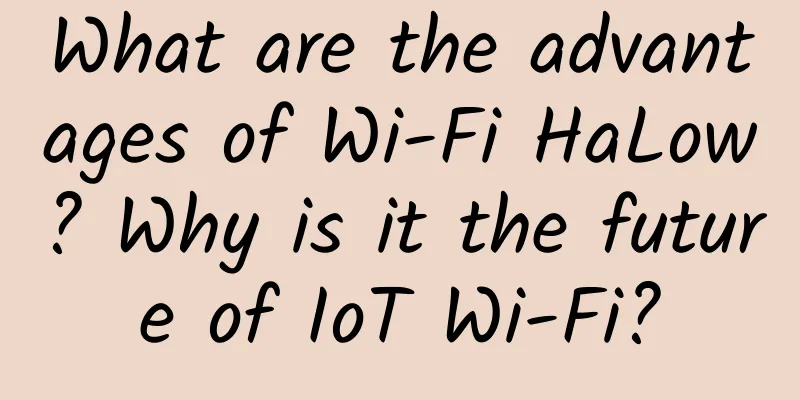What are the advantages of Wi-Fi HaLow? Why is it the future of IoT Wi-Fi?

|
Connectivity is critical to every aspect of our lives and work. From wearables to security systems to factory automation equipment, connecting, monitoring, and controlling the various IoT devices used by businesses today are essential capabilities. So, what is the future of Wi-Fi? According to McKinsey, the total number of IoT devices worldwide is expected to exceed 30 billion by 2025. Enterprises are beginning to adapt to this growing demand for connectivity. In less than a decade, the number of enterprises deploying IoT technology has nearly doubled and will continue to accelerate. Wi-Fi (using the 802.11 standard) has become the most popular protocol for wireless local area networks (WLANs) today. Recent generations of Wi-Fi (4, 5, and 6) have provided excellent data rates over short distances, ideal for ultra-high-resolution video streaming, virtual reality, and other data-intensive applications. However, these protocols were not designed to cover many of the applications that enterprises now demand from their IoT device inventory. In recent years, a new long-range, low-power Wi-Fi protocol has emerged to meet the unique needs of IoT connectivity, namely the Wi-Fi HaLow (IEEE802.11ah) standard. The Wi-Fi Alliance launched the new Wi-Fi CERTIFIED HaLow™ program on November 2, 2021, which is a turning point for the industry. HaLow is the future of IoT Wi-Fi Wi-Fi HaLow is a game changer for enterprise IoT applications that require a combination of long range, low power consumption, high data rates, high network capacity, and advanced security. Applications range from factory and building automation to fleet and asset management to smart agriculture and smart city infrastructure. Here are some of the key benefits of Wi-Fi HaLow for enterprise connectivity: Wi -Fi HaLow has a range of about 1 km, which is 10 to 100 times that of 2.4GHz Wi-Fi or Bluetooth, making it ideal for use in warehouses, factories, retail stores and other large campus environments. Wi -Fi HaLow signals operate in the sub-1GHz frequency band, which can more effectively penetrate physical barriers such as walls, floors, and other obstructions than other higher-frequency protocols such as Bluetooth, traditional Wi-Fi, or Zigbee operating at 2.4 GHz. Wi-Fi HaLow reduces the operational cost and complexity of deploying end nodes such as wireless sensors and detectors in locations beyond the range of the 2.4GHz protocol, which would otherwise require range extenders or additional access points (APs). As enterprise applications continue to apply artificial intelligence (AI), machine learning (ML), and big data analytics, there is an increasing need to deploy more sensors to collect more data. Wi -Fi HaLow is more energy efficient than previous Wi-Fi options, providing IoT devices with multi-year battery life and reduced energy consumption. Wi -Fi HaLow is an inherently secure wireless protocol that supports the latest Wi-Fi authentication and encryption requirements, including WPA3 and AES for over-the-air (OTA) traffic. Wi -Fi HaLow is an open 802.11 standard. This simplifies the installation process and reduces operating costs because no dedicated gateways, controllers or hubs are required. This ensures that 802.11ah technology will always be free, unlike some other proprietary connectivity solutions that require fees. How to implement HaLow in your company's technology strategy Many enterprises rely on complex mesh networks to connect and control their vast inventory of IoT devices. With its large network capacity and long coverage, Wi-Fi HaLow eliminates the need for difficult-to-deploy mesh networks. The standard also simplifies enterprise network deployment, reduces security network infrastructure, minimizes installation and maintenance costs, and reduces installation time. Wi-Fi HaLow should be a key part of any conversation addressing current IoT needs. Most businesses undergo frequent information technology (IT) audits, so an easy first step is to add IoT connectivity requirements to your next audit. Enterprise IoT network requirements are already extensive and will continue to grow in the coming years. As part of your IT audit, cross-reference your organization’s IoT requirements list with the unique benefits of Wi-Fi HaLow. As a protocol designed specifically for IoT, Wi-Fi HaLow may be able to meet your organization’s connectivity needs as well as a custom solution. As you build and refine your IT technology roadmap, develop a plan to integrate Wi-Fi HaLow technology into your network topology and discuss the HaLow certification program with your equipment vendors to include HaLow-enabled devices and networks in your implementation plan. The duration and cost of deploying Wi-Fi HaLow technology in an enterprise network will depend on the current network architecture and other wireless protocols used. Any update or revision requires planning and resource allocation, but Wi-Fi HaLow is expected to be relatively easy to implement. Wi-Fi HaLow was created in part with the goal of simplifying network management by using an easily deployable wireless technology that eliminates the need to rip out existing wiring and lay new cables when devices need to be added or network coverage expanded. Because Wi-Fi HaLow is compatible with existing Wi-Fi protocols (e.g., Wi-Fi 4, Wi-Fi 5, and Wi-Fi 6), it will not affect the RF performance of any enterprise already using these Wi-Fi protocols. As the enterprise IoT device inventory continues to grow, the need for simplified, easy-to-deploy, and secure connectivity will move up the enterprise priority list. Wi-Fi HaLow was designed with this reality in mind. While technology innovation will continue to accelerate, no wireless protocol can currently match the unique combination of power efficiency, extended range, network capacity, advanced security, Wi-Fi compatibility, and native IP support that Wi-Fi HaLow offers—and this is the future of Wi-Fi. |
<<: The most anticipated technology trends in 2023
>>: IoT security and vulnerabilities that 5G will bring
Recommend
What is Industrial Ethernet? What are its advantages?
Industrial Ethernet is an industrial network deve...
How to share WiFi gracefully when the password is hard to reveal
"What's your home WiFi password?" T...
Three misconceptions about 5G
In late 2019, IDC predicted that the number of 5G...
Is it really possible for humans to achieve immortality on the Internet?
Through the connection of virtual network devices...
10 bad habits network administrators should avoid at all costs
Every enterprise network consists of devices that...
edgeNAT newly launched South Korea SK direct connection VPS with 20% discount on monthly payment and 30% discount on annual payment, 2G memory package starts at 48 yuan/month
edgeNAT has newly launched the Korean three-netwo...
NGINX Sprint China 2022 Conference: Embracing open source to help modernize applications
Recently, the NGINX Sprint China 2022 conference ...
Changing WiFi channels can help you enjoy faster network speeds
In our daily life, when we connect our computers,...
Wireless Broadband Alliance: 5G should not be viewed in a narrow sense and can coexist harmoniously with Wi-Fi 6
Tiago Rodrigues, who took over as CEO of the Wire...
HostKvm Hong Kong VPS 30% off: $5.95/month KVM-2GB RAM/40GB hard drive/500GB monthly bandwidth
HostKvm is a foreign hosting service provider fou...
Google's OnHub routers will stop supporting software in December next year
Google announced today that it will stop software...
RepriseHosting: $25.97/month-L5640, 16G memory, 1TB hard disk, 20TB/1Gbps, Seattle data center
This is a promotional activity released by the me...
Why do 5G mobile phones support more frequency bands?
How many 5G frequency bands a mobile phone can su...
What IoT strategies do global operators have?
After several years of preparation and developmen...
Riverbed is your smarter choice to accelerate your business with the power of digital experience management
[Original article from 51CTO.com] In the context ...









